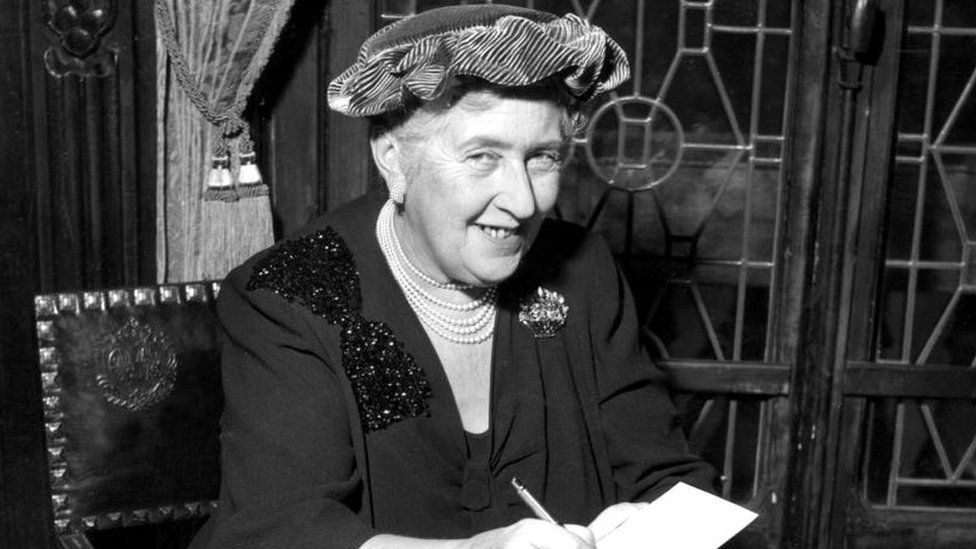ARTICLE AD BOX
 Image source, Getty Images
Image source, Getty Images
Agatha Christie named her house Styles in 1924 after the success of her first novel
By Cherylann Mollan
BBC News, Mumbai
Few things are more gripping than a family feud - especially when the relatives involved aren't yours and murder is part of the plot.
Agatha Christie, often called the "queen of crime", knew this better than most and her very first novel, The Mysterious Affair at Styles, treats the reader to an intriguing tale of murder born out of familial strife.
Published in 1920, the whodunnit centres around the murder of a wealthy woman, Emily Inglethorp, whose second husband - 20 years younger than her - is viewed with suspicion by the entire Inglethorp clan, including by her friend and confidante, Evelyn Howard.
The book introduces one of Christie's most iconic characters - the eccentric detective, Hercule Poirot - and like her subsequent books, had multiple suspects, shocking twists, clues hidden in plain sight and the "big reveal" at the end, where the perpetrator of the crime is revealed.
But the novel is also singular in that it is widely thought to be inspired by a real-life murder that took place over a century ago in Mussoorie, a popular hill retreat in northern India.
In September 1911, Frances Garnett Orme, 49, was found dead in her room at the Savoy, an upmarket hotel built by an Irish barrister. A post-mortem report found that Orme had been poisoned with prussic acid - a cyanide-based poison. Her friend, Eva Mount Stephens, 36, was accused of murdering her.
The case made global headlines because of the "peculiarity of the circumstances surrounding it", as one Australian newspaper noted in 1912. British newspapers carried blow-by-blow accounts of the trial with headlines like 'Mussoorie murder trial', 'hotel mystery' and the 'crystal gazing trial'.
Indian author Ruskin Bond, who lives in Mussoorie and has written extensively about the tranquil and verdant hill town, drew a connection between this famous murder and Christie's first book in one of his essays. He says that Christie "used the circumstances of the crime" in her book as the case was "quite a sensation" in its time.
Image source, Getty Images
Image caption,Hercule Poirot is one of Christie's most iconic characters
According to reports, Orme had been living in India for more than a decade, and had met and befriended Stephens, a spiritualist who hailed from Lucknow city. Orme, a "lonely woman", is reported to have learnt crystal-gazing and other occult practices from Stephens.
The two had stayed together at the Savoy for a while, during which time Stephens claimed to have looked after Orme as she was in poor health. But the prosecution accused Stephens of administering poison to Orme to benefit from her will as the latter had left her friend a hefty sum of money, three necklaces and other jewellery.
The defence, on the other hand, claimed that Orme killed herself because of the "unceasing grief" she experienced after the man she came to India to marry died, as well as her own ill-health.
The case confounded many, including the police, because of its twists and turns. For one, the investigation revealed that Stephens had left for Lucknow before Orme had died. Secondly, the room in which Orme's body was found was locked from the inside.
The police also found no medicines in Orme's rooms except for a bottle of sleeping pills and two labels - that of arsenic and prussic acid.
In the early 1900s, buyers had to sign for drugs they bought from a chemist, but the prosecution pointed out that the signature for the prussic acid didn't match the one on Orme's letters.
The prosecution also said that Stephens, in conversation with a friend, had predicted Orme's death six months in advance and had also voiced apprehensions about Orme marrying a physician she was engaged to and leaving all her wealth to him.
But the defence insisted that Stephens was a "most devoted companion" to Orme and that there was no proof that she had either bought or administered the poison to her friend.
Stephens was finally acquitted, with the judge remarking that the "true circumstances of Ms Orme's death would probably never be known".
Spoilers ahead for The Mysterious Affair at Styles
Christie's book mirrors many of these developments. Emily also dies due to poisoning, and just like Orme, her body is found in a room locked from the inside. It is revealed at the end that it is her companion, Evelyn, who poisons her - it turns out that she bought the poison in disguise, using a forged signature, and that she had a financial motive for killing her friend.
She also leaves the Inglethorp residence much before Emily's death. So how exactly did she do it? Only Poirot can answer that!
Decades later, the similarities between the cases continue to intrigue fans - Indian crime writer Manjiri Prabhu spoke about the "interesting connect" between Christie's first novel and the Mussoorie murder at the International Agatha Christie Festival in 2022.
Image source, Getty Images
Image caption,During World War I, Christie worked as a nurse, thus acquiring knowledge about poisons
Christie wasn't the only author who was inspired by poison deaths in India. Cecil Walsh chronicled a crime of passion that unfolded in Agra - then a territory under the United Provinces of Agra and Oudh in British-ruled India - and shocked the world. In The Agra Double Murder: A Crime of Passion from the Raj, he writes about how Augusta Fullam, an Englishwoman living in Meerut city, and Dr Clark, an Anglo-Indian man, conspired to poison their respective spouses so that they could be together.
Much like in the US and Europe, poisoning cases were common in India in the 19th Century. The sale of toxic substances, particularly arsenic, was unregulated. In his book, Toxic Histories: Poison and Pollution in Modern India, David Arnold writes about how arsenic poisonings provided the "primary impetus" for framing of the Indian Poisons Act in 1904 to regulate the sale and use of poisons.
"When it came, 10 years on, to review the working of the Poisons Act in 1914, the UP (United Provinces) government referred to two notorious cases of poisoning in the province in recent years - one the Orme murder, the other the Fullam-Clark case," he writes in the book.
True crime remains a fascinating genre and continues to captivate audiences through films, podcasts and web shows. But for Christie's fans, The Mysterious Affair at Styles will always occupy a special place in this grisly canon.

 1 year ago
45
1 year ago
45








 English (US) ·
English (US) ·